The exact steps to take in order to lose weight, get ripped like an underwear model, maintain your weight, or even pack on slabs of lean muscle mass without counting calories
If you are reading this article, my guess is that you either hate counting and tracking your macros or you have struggled to lose weight and are looking for a better approach than meticulously logging your food every day. You’re in luck! I’ve dealt with this problem… a lot.
As, San Francisco’s best personal trainer I work with a lot of very diverse clients. From engineers and venture capitalists to designers and lawyers. I’ve worked with men and women from all walks of life and as a result I’ve gotten a good sample size and the fact is… most people simply hate logging their food.
If you are one of these people, what should you do? Are you just screwed?
Lucky for you, there is a solution out there. Although it was popularized a long time ago by the legendary Bill Phillips in the 1990s it has been lost in the shuffle amongst all the new and exciting fad diets.
I’m here to bring it back into the foreground and show you how you can use it (like I did) to get as ripped as an underwear model, maintain your weight, or even pack on lean muscle mass.
Let’s get er done:
What is Flexible Dieting?
Flexible dieting is all the rage right now. Seriously, what fitness enthusiast isn’t posting a picture of an In-n-Out cheeseburger and hashtagging #iifym (if it fits your macros)? I know I’ve done it.
If you aren’t familiar with fitness jargon, flexible dieting is another term for the If It Fits Your Macros (IIFYM) diet which has gained enormous popularity over the years. Essentially, the diet boils down to this point:
How many grams of proteins, carbohydrates, and fats you eat (i.e. your macros) matter far more than exactly what you eat.
This means that as long as you track your macros and eat for a set number of proteins, carbs, and fats every day then you can achieve any body composition goal you want from losing weight to maintaining your weight or even packing on lean muscle mass.
As Professor Mark Haub taught us in his now infamous Twinkie diet — this is absolutely correct. Quantity is more important than quality and as many of my clients have learned… the idea that eating “healthy” equals automatic weight loss is completely false.
If you eat nothing but chicken breast, brown rice, and avocado all day then congratulations because that’s very “healthy” of you. High five. However, if you eat more calories than you burn each day — you will still gain body fat and look terrible in a swimsuit. I know, the world is unfair 🙁
The Benefits of Flexible Dieting
The major benefit of flexible dieting is that it absolutely works. Eat your macros every day, as long as they are the right macros to support your goal, and you will achieve your desired result. It’s that easy.
Another benefit of flexible dieting is that it’s less restrictive than other diets (although this is a blessing and a curse). You are allowed to indulge in any and all of your favorite foods as long as it fits your macros. That means I can eat Kara’s Cupcakes every single day as long as I fit it into my daily macros.
And because you are allowed to eat your favorite foods anytime you want the diet is often said to be more sustainable over the long-term because it’s non-restrictive therefore it doesn’t feel like a diet. It’s more of a lifestyle.
Hell, one of my best clients Christoph (read his case study here) used this approach brilliantly and made an incredible transformation: 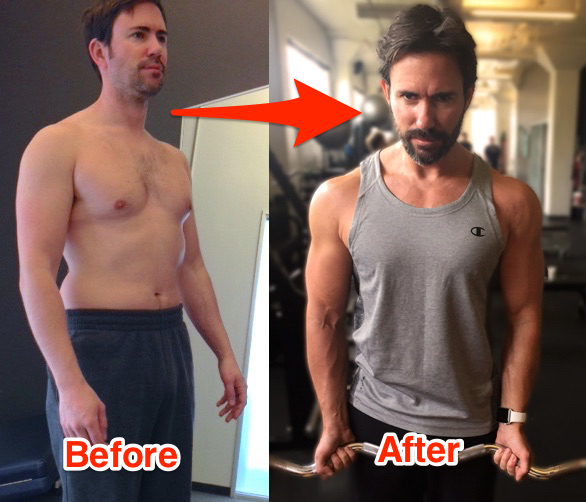
Sounds awesome, right? Or is it?
The evil side of flexible dieting
Now, before you run off and start hashtagging #iifym on your Instagram let me introduce you to the evil side of IIFYM.
Full disclosure: I practice flexible dieting in my own life (kinda). I count my macros 6 days per week although I tend to eat 99% “clean” foods. I have 1 day of anarchy and lawlessness on the weekend. Every once in a blue moon during the week I’ll indulge in something… if it fits my macros 😉
That being said, I guess you can say I practice flexible dieting or if it fits your macros although not exactly as it’s intended.
The issues I have with flexible dieting span from my work as a personal trainer at San Francisco’s #1 personal training facility DIAKADI Body. To provide context, I’ve worked with hundreds of people helping them get in kickass shape and I’ve even helped enough people get awesome enough results that I was named San Francisco Magazine’s “Best Personal Trainer for Abs” in 2015.

As a result of working with so many different people over the years I’ve seen what works and what doesn’t. And the fact is that flexible dieting doesn’t work for many people for two very glaring reasons:
- Lack of self control
- Lack of attention to detail
Give an inch and They’ll take a mile
Ever heard the expression, give an inch and they’ll take a mile? Well, one of the reasons flexible dieting doesn’t work for a lot of people (about 68% of my clients) is because they don’t have an “off” switch when it comes to their favorite foods and that lack of self control leads to failure.
For example, if you allow most people one (1) cookie (if it fits their macros) they’ll start with the intention of only eating 1 cookie but 4 cookies later they’ll have blown their load and went way over on their macros. If you’ve ever read the book Mindless Eating then you know self control is difficult if not impossible for most people when it comes to food.
As a result of blowing their load on cookies the person will become frustrated and fall right off the cliff for the rest of the day eating whatever they want because they already screwed up anyway.
Some people (not all) deal better with restriction than they do with getting an inch and being able to eat “just a little bit” of their favorite foods. For the record, I fall into this category and that is exactly why I eat clean 99% of the time during the week. If you’ve seen my Instagram you know I can’t just eat one Kara’s Cupcake I must eat 4. I’m either all in and all out.

Know thyself. If you fall into this category and cannot practice self control when it comes to your favorite foods (like me) then you either have to avoid them entirely and practice my style of IIFYM or you must try something else like portion control method (keep reading).
Lack of Attention to Detail
The other problem I’ve seen with flexible dieting is that many (roughly 68%) of the people I work with just cannot seem to manage to count and track their macros on a daily basis. Whether they struggle with self control like I described above or they just get lazy, forget to track, etc. This almost always happens on days when they eat out at a restaurant because they aren’t sure what to log.
Let’s get real for a second. Tracking your calories on a daily basis, as I describe in my How Many Calories Should I Eat blog post, is really freakin’ hard. It’s a massive lifestyle change for most people and it doesn’t just happen overnight unless you are really OCD or really motivated.
Luckily for me, I’m both. I have a degree in computer science and worked a software engineer for a few years so I’m absolutely OCD and detail oriented. And my income now as a personal trainer is very much tied to my physical appearance.
Most people do not fall into that category and just cannot and will never be able to manage to track everything they eat or drink with calories on a daily basis. Statistically speaking, this makes sense. Just look at a bell curve:

The Top 16% of People
Some people, roughly 16% will fall into the upper end bucket and will have no problem with tracking macros and following a flexible dieting approach. They are detail oriented and motivated. They love quantifying their health and fitness and unlike most people — it takes little to self control or discipline to do. They just do it and make it look easy.
Of course, these are the easiest clients to train because all you have to do is give them a plan and they can execute 24/7 even when you aren’t with them. It’s awesome and they always get amazing results. This doesn’t make them better people it just makes them good at tracking their food.
The Average 68% of People
The majority of people that fall into the “Average Person” bucket that makes up about 68% of the population and will struggle with flexible dieting. They’ll have some good days, they’ll have some bad days. When they are extra motivated (like if a vacation is coming up) they might be really on point and get great results but they’ll also go through periods like that period between Thanksgiving and Christmas when they’ll gain 8 pounds. Again, this doesn’t make them good or bad people — it just makes them average at tracking their food intake.
The Bottom 16% of People
Then we have some people, roughly the other 16% that fall into the lower end bucket and will just fail miserably at tracking macros and flexible dieting. It simply won’t work and it will never work. This doesn’t make them bad people — they just need a different approach. The only hope these people have is if they are self aware enough to realize this or fortunate enough to work with someone like me that help guide them into something that will work like portion control dieting.
What is portion control dieting?
Portion control dieting was popularized by the legend, Bill Phillips, in his awesome book Body For Life back in the 90s. For some reason it sort of lost popularity amongst all the dieting fads such as The Atkins Diet, South Beach Diet, Mediterranean Diet, Paleo Diet, Zone Diet, Vegetarian Diet, Vegan Diet, Raw Foods Diet, etc. As you can see, it’s easy to fall off the radar with so many ways to eat for weight loss.
Portion control dieting is simple… instead of counting macros, calories, or eating some fancy diet that restricts certain types of foods all you have to do is this:
1. Eat the right foods
Nothing magical here… just eat foods that are high in nutrients and low in calories. Brilliant! As you would imagine things like chicken, turkey, lean ground beef, brown rice, sweet potatoes, broccoli, cauliflower, spinach, kale, blueberries, blackberries, and raspberries are all on the list.
2. Eat the right amounts
Again, this isn’t brain surgery and this is where the diet gets its name in case you haven’t guessed it. Eating the right amounts isn’t as hard as it might seem and this is why you don’t have to count calories. For example, a protein portion will be equal to the palm of your hand. The beauty of this strategy is that the size will fluctuate for male and female based on the size of your hand. A carbohydrate portion will be equal to the size of a closed fist. The vegetable portion of your meal will be equal to the rest of your plate. One word of caution, make sure you use a regular sized plate and not one of those ridiculously large restaurant plates.
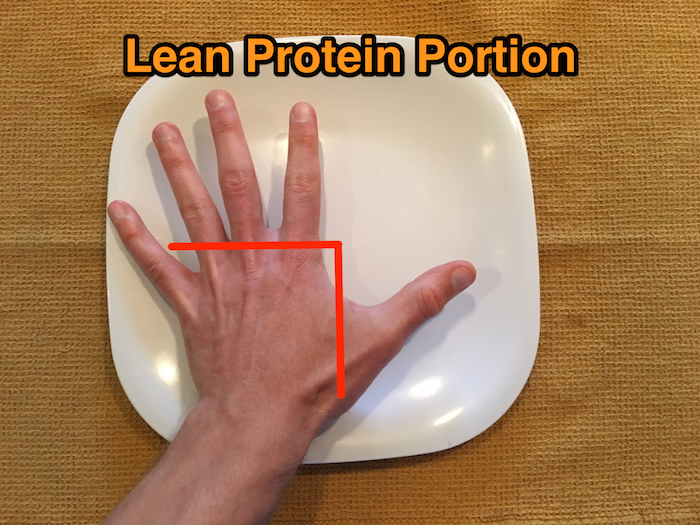
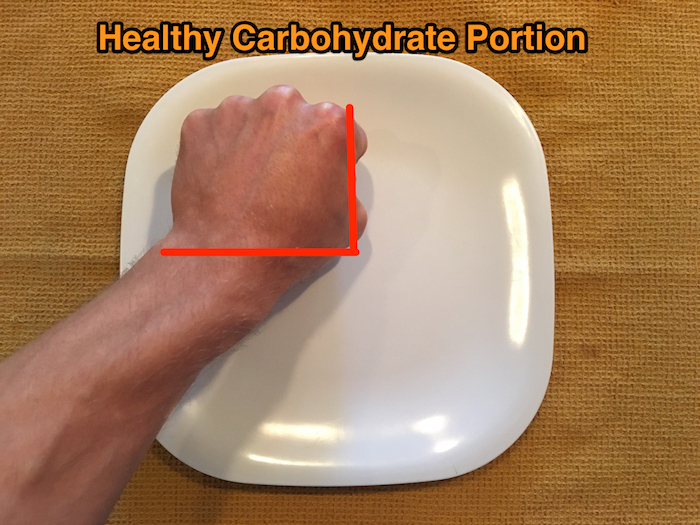
3. Eat the right combinations
Now that you are eating the right foods in the right foods in the right amounts we need to combine them into a balanced and nutritious meal that is going to fuel your body. Combinations can vary depending on your goal (see below) but the standard meal will consist of:
- 1 lean protein portion
- 1 healthy complex carbohydrate portion
- 1 vegetable portion (I like non-starchy veggies for this portion)
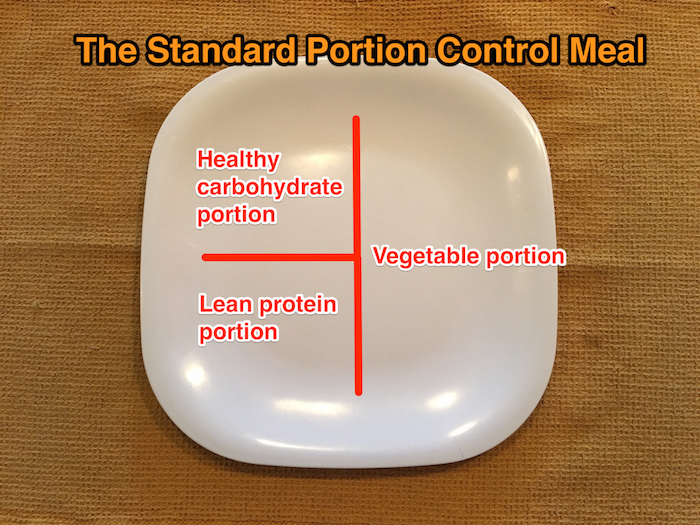
4. Eat At The Right Number of Meals
As you may know, I’m a big fan of intermittent fasting so instead of Eat At The Right Times and telling you that you should eat every 2.5-3.5 hours, I’ll tell you that you should eat 3 portion control meals or 3 plates per day. That means you can spread them out across your entire day eating a traditional breakfast, lunch, and dinner or eat them one after another in combination with an intermittent fasting protocol like I do. Either way, just make sure you consume 3 plates of foods per day as your “meals.” However you want to break that up in terms of timing is your business.
5. Have one free day per week
Just like the slow carb diet you can have 1 free day or cheat day per week. Here is how I use mine. And like me, most people like to take this on the weekends when eating is involved in almost all social engagements with friends and family. Plus it’s nice to be able to indulge in some of your favorite foods guilt free without having to track your calories and make sure it fits your macros. It’s very freeing.
One word of caution on your free day: do NOT eat until you make yourself sick or even throw up. I’ve had clients that do this… hell, I’ve done it! Trust me, it’s not healthy and it’s easy to sabotage your results by overdoing it when you take your cheat day to this extreme extent.
You may be tempted to say that one day of eating badly is not going to ruin 6 days of eating healthy but when you eat until you make yourself sick I’d argue that point. Not only is eating to this extent mentally unhealthy and a direct indicator of a poor relationship with food, but at this level you are going beyond the positive benefits of a cheat day. Just don’t do it. Enjoy your day, eat until you are full or even very full but don’t make yourself sick. For more info read my blog post How Eating Cupcakes Will Help You Burn Fat.
What are the benefits of portion control dieting?
If you absolutely loath counting macros or have struggled to make progress with flexible dieting then you are going to love this: YOU DO NOT HAVE TO COUNT CALORIES WITH THE PORTION CONTROL METHOD!!
Hallelujah! No more counting macros or logging your food.
The other obvious benefit is that it’s very easy to implement, takes far less time and attention to detail than IIFYM, and it works. At the end of the day there are results and excuses and portion control works. And in my experience it works very well for those people that struggle with counting calories, macros, or flexible dieting.
What are the drawbacks of portion control dieting?
The downside of portion control is that it isn’t nearly as precise or exact as counting macros. If you are super OCD, extremely detail oriented, or love tracking your fitness then portion control might drive you crazy. Although I’ve used the portion control method before I just love knowing my exact macros each day and I just find tracking my food so interesting and fascinating. I know, I’m weird.
Another downside is that you still have to track your portion sizes. Yes, there is still something to keep track of! There are no free lunches. That means that if you’ve been using the traditional method above and aren’t losing weight, you may need to modify your carb portion and reduce it by 50%. Instead of having a carb portion equal to a closed fist you may need to reduce that by half.
Lastly, if you go out to eat during the week or any day that isn’t your cheat day then YOU WILL have to stick to the plan. That means you’ll be leaving some food on your plate because most restaurants over serve and provide you way more calories per meal than you actually need. They also use gigantic plates which directly affects how much you will eat. Yes, a bigger plate results in you eating more food. Don’t believe me? Read Mindless Eating… I’ll wait here. All good now? Great.
Here is what you do if you are out to dinner: use your hand and your fist to measure and cut off any excess from your protein and your carb portion and put them aside then eat the equivalent of a handful of vegetables. If you have no self control place the extra portions on a separate plate and have your waiter or waitress take it away. Simple.
How To Implement Portion Control Method
If you want to implement the portion control method in your life to lose weight, maintain, or even bulk up (yes, you can use it to bulk) then follow a meal plan like this:
Meal #1
- 1 Lean Protein Portion
- 1 Healthy Carbohydrate Portion
- 1 Vegetable Portion
Small Snack #1
- Protein shake and 1 handful of raw almonds
Meal #2
- 1 Lean Protein Portion
- 1 Healthy Carbohydrate Portion
- 1 Vegetable Portion
Small Snack #2
- Protein shake and 1 handful of raw almonds
Meal #3
- 1 Lean Protein Portion
- 1 Healthy Carbohydrate Portion
- 1 Vegetable Portion
Small Snack #3
- Cottage cheese, low calorie dessert, or casein protein
Again, feel free spread these meals across as many hours as you’d like. The important aspect of this diet is the portions not the timing of meals.
The Lose Weight Fast Approach
When I was doing fitness and underwear modeling in New York (see pic below) I implemented a variation of the portion control method that was very effective for fat loss. It works wonders whether you want to be ripped to the bone or just lose a bunch of fat. I call it the Underwear Model Diet.

There is a saying in the modeling world, “off-season” equals unemployment. In other words, I couldn’t financially afford to be anything but ripped to the bone. No joke, I’d have to go to castings every single day and they expect you to look awesome — like photoshoot ready awesome. And this variation of the portion control method will accomplish that.
If you are already lean, you will like you are ready to shoot the cover of Men’s Health every single day of the week. If you have a few pounds to lose and you implement this variation of the diet — you will lose weight fast… very fast!
So, how does it work?
Simple… just eliminate your portion of carbohydrates and replace them with vegetables. Your meal will now consist of 1 portion of lean protein and the rest of the plate will be filled with vegetables. It looks like this:

One word of caution about this diet: if you are an endurance athlete or lifting weights like an animal 5-days per week it is not sustainable for the long-term and should be used only as a short-term method to lose a lot of body fat. Long term, you are simply working out way too much for such a low-carb diet.
However, if you are doing a cut or even a mini-cut… this type of diet is very effective for a matter of a few weeks at a time. Try it for 2-4 weeks then slowly reintroduce carbs back into your diet so you don’t balloon up (reverse diet).
The Slow & Steady Approach
This is the standard portion size control meal plan and this can be used to either slowly lose weight, maintain your weight, or slowly bulk up. Modifying your exercise intensity, frequency, and training style will determine which road you take.
Let me rephrase if that’s confusing: when eating roughly your maintenance calories for a given day you can easily lose, maintain, or gain weight (albeit slowly) by adjusting your training:
- If you are training intensely 4 days per week using protocols like Metabolic Resistance Training Circuits then you’ll slowly lose body fat.
- If you are training with moderate intensity lifting weights 3-4 days per week then you’ll maintain your weight.
- If you are training intensely 3x per week with a hypertrophy focus then you’ll slowly gain lean muscle mass.
Of course, you may need to tweak your portions or your training to achieve the desired result but I think you get the point. Meals using this approach would look like this:
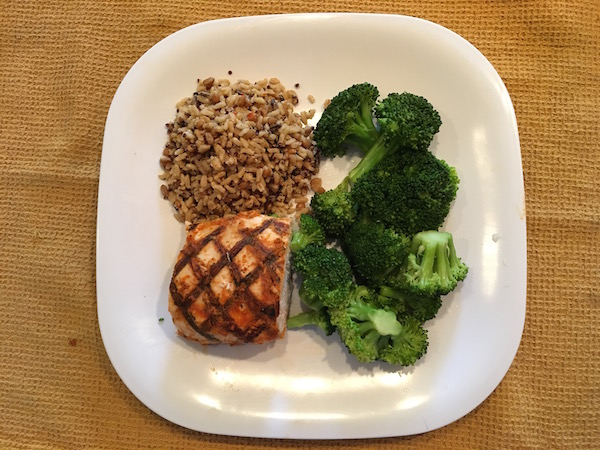
Given my hand size, this is roughly 7-8oz of chicken, 1 cup of brown rice, and large handful of broccoli.
The Muscle Building Approach #Gainz
Yes, it’s even possible to bulk up and pack on plenty of lean muscle mass using the portion control diet as well. In order to do this all you need to do is double your carb portion. Yep, that’s it.
Just make sure your training is complimenting this type of eating. With all these extra carbs you need to move some weight boy otherwise you’ll just end up getting fat.

For me, this is roughly 7-8oz of chicken, 2 cups of brown rice, and handful of broccoli.
Pick A Plan & Execute!
As I’ve said in the past with your workout plan… the most important thing is just to actually have one. Same thing goes with your diet. The most important thing is to simply have a diet plan and the second most important thing is to actually follow it.
Whether you try flexible dieting (IIFYM) or one of the variations on the portion control method the most important thing you can do today is to pick one plan and stick with it for the next 4-weeks. That’s right, a whole 4-weeks. I find that dieting takes about 4-weeks to “set in” with people.
If you try something for a day, two days, or even a week and then fall off the wagon then try again you’ll never be able to make any progress and you’ll never get over the initial pain barrier of implementing a new habit or behavior in your life. Therefore you’ll never really know if you like it or even if it works.
Commit to a plan for 4-weeks and execute on it like you have a gun to your head. At the end of those 4-weeks you can better measure your progress (if any) and identify if you actually like the plan and it fits your lifestyle.
Have you struggled with flexible dieting and logging your food? Have you had success with the portion control method? Leave a comment and let me know!
